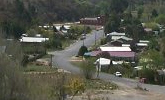| And so, on 9 March 1962 mining stopped at Captain's Flat. The announcement was sudden and caught the miners and townsfolk by surprise. Following immediately on the heels of the official notice of closure, the company dismissed 300 workers. Fifty others were retained to dismantle equipment.
Almost within hours of the mine closure, Captain's Flat began to disappear. In April, the town doctor resigned and by May the Catholic convent was closed. Only 12 shops remained out of the 32 that were trading prior to the closure. In a matter of a few months, Captain's Flat's population had halved.
Lake George Mines' buildings and equipment was auctioned in February 1963. The sale lasted a full week and bargains ranged from household items to the mine head poppet. Houses were snapped up for a few dollars, most being trucked away to Queanbeyan for relocation. The mass exodus of these cottages led the local councillor to petition the state government to prevent this loss of the town's heritage. A bill was drawn up preventing further removals of buildings, but by that time, many fine old cottages were gone. Locals also petitioned the Federal government for funds to seal and upgrade the road between Queanbeyan and Captain's Flat. In mid-May 1962, the government supplied £100,000 for the road works. This is what possibly saved Captain's Flat from becoming a ghost town.
Another service which closed its doors soon after the mines closed was the hospital. Built and dedicated in 1945, it was at one time one of the most modern and best equipped hospitals in the southern hemisphere. The State Hospital Commission claimed all the equipment for itself which created much ill-will with locals who had, over the years, mostly paid for it themselves. Arrests were made when a number of local men tried unsuccessfully to stop the removal of the equipment. The nurses' quarters was rented by the Electrolytic Zinc Corporation as its headquarters in 1972, when it conducted test drilling, but this was a short term arrangement when the drilling proved unsuccessful. Today the hospital houses the Yesteryear Museum. Other services closed; the taxi company and bus line; and the ANZ bank closed its doors in 1977.
The railway service declined markedly upon the mine closure until finally on 1 September 1968, the last train ran the line. The line was reopened in part a year later, for the making of the feature film "Ned Kelly", starring Mick Jagger. The railway station was converted into a 2 bedroom dwelling in 1974.
Of the three churches built in Captain's Flat, now only St. Luke's Anglican church remains. The school continued after the mines closed with enrolments declining to about 30 children from the previous 200.
Perhaps the biggest problem caused by the mines, were the huge sludge pits left at both ends of town. These were filled with toxic waste tailings from the mine operations and remained open. When the tailings became exposed to water or air, toxic sulphates were formed which, if not handled and contained adequately became a dangerous problem. The walls of the dumps had collapsed previously, in 1939 and 1942. Then in 1945, flooding caused a major overflow of wastes into the Molonglo River which swept downstream and poisoned over 1000 acres of prime agricultural land. The company limed the area, but to this day the land is still adversely affected. In 1954, tailings were handled differently. After evaporation to an 8% moisture content, the wastes were built into hills. Over the years these waste dumps rose to over 40 metres above the town and after every rain, toxins leached and eroded into the river. There were some 1.5 million tons of waste casting a dangerous shadow over Captain's Flat. The department of mines spent considerable money in 1968, filling in ventilation shafts and reinforcing the walls of the slime dumps, but this was really only a cosmetic change. Locals voiced concerns regarding the remaining waste dumps but were ignored until it was discovered that mine waste had been swept 50 kilometres downstream into Lake Burley Griffin in the heart of Canberra, the nation's capital. This prompted swift action, the picture of the carefully planned city of Canberra being polluted, obviously not sitting well with politicians and bureaucrats. So in 1974, work began on a major reconstruction and revegetation project where the hills were reshaped, the sludge pits filled with clay and rocks and the whole lot covered with soil and planted with grasses and other vegetation. Although this made a considerable difference, the problem of chemicals and heavy metals leaching into the river remains, with zinc contamination a real danger.
Since the mines closed in 1962, other industries have tried their luck in Captain's Flat. In the early 1970's, a sawmill was opened just out of town, but over the years, the fluctuations of the timber industry caused its demise in the 1990's. The Captain's Flat area has been host to two movie sets, the first being "Ned Kelly" in 1969, then again in 1978 for the movie, "My Brilliant Career".
In 1981, the residents of Captain's Flat expressed deep concern regarding the quality of the water supply. The town dam was heavy with pollution from sheep grazing above the dam, with the wastes washing into the dam after heavy rain. The council hired divers to explore the dam and after they recommended the intake pipes be raised higher up the dam wall, the problem was quickly rectified. The dam had never been intended for use as a supply of domestic water but after the mines had closed, it was upgraded and work carried out to improve the quality of water. At one point, scientists claimed that the water at Captain's Flat was a healthful tonic, being rich in minerals. Major works have been proposed to completely overhaul and upgrade the water supply over the next few years.
Today, Captain's Flat is a sleepy little village still nestled in its hilly retreat. The big dollar days have long gone and life moves at a much slower pace. The hotel still quenches the thirsts of locals and visitors alike. The swimming pool still attracts children on hot summer afternoons and the Post Office still delivers the mail. From the hills above, the village looks like any other little Australian town, it is only when one spends time here, walking the streets, chatting with the older residents, that the rich and lively past is revealed. It is an enigma, a town built on the fickles of mining and little else. But through all the ups and downs, the highs and lows, Captain's Flat has tenaciously clung to life with a spirit which perhaps has its origin in the heart of a mighty beast of burden some 120 years ago. A beast named "Captain".
|

Overlooking the town just prior to the mine closure in 1961
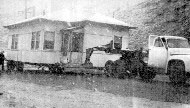
A house moving out after the mines closed. Houses disappeared overnight being bought for a few dollars and trucked away for relocation.
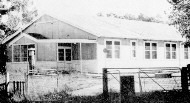
The hospital shortly after its closure. In its heyday it was the best equipped hospital in Australia

The Captain's Flat railway station. The building was later fitted out as a dwelling
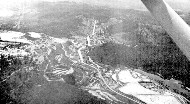
Overhead view of the tailings waste dumps at both ends of town. These dumps were an extreme health hazard
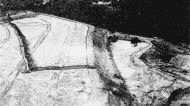
Another view of the waste dumps
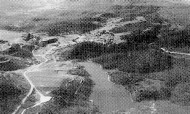
The dumps after work was carried out to cover the toxic waste

The Pre-school shortly after its opening, built by the locals with money raised in the district

Divers inspecting the dam wall after a major pollution scare
|
